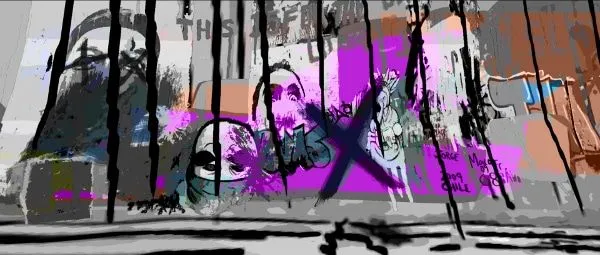Eye For Film >> Movies >> Wall (2017) Film Review
Wall
Reviewed by: Amber Wilkinson

The ongoing Israel-Palestine issue is given a personal spin by David Hare in Cam Christiansen's animated adaptation of the playwright's monologue, which was written for the stage in 2009. More than simply a study of one particular conflict - although that is its main sweep - Hare also offers a critique of the ways labels can be used to reinforce ideology.
The wall of the title refers to the Israeli West Bank barrier that runs more than 400 miles and has been branded in breach of international law by the International Court of Justice. It is called "a separation fence" or "a racial segregation wall" depending on your viewpoint. "The words tell the world which way you think", we're told and this idea of picking a side through semantics runs throughout the film which is shot, for the most part, in appropriate tones of black and white.

Hare has a curiosity for both sides of the argument and takes his journey into grey areas, making this a much more thorough examination of the situation than many of the films that focus on this part of the world. Acknowledging that the wall "works" in terms of reducing terrorism, Hare goes on to explore the ways in which it also fails, and how attitudes on both sides of it may be stymieing the peace process even further.
The barrier may have been constructed to keep people out but Hare raises the spectre of a gilded cage. While highlighting the genuine fears of Israel, he also asks uncomfortable questions about the settlers (those interested in that might want to check out Shimon Dotan's comprehensive film on the subject) and to what extent the violence the barrier was intended to suppress might be fuelled by the tensions it creates. One of the biggest losers also seems to have been the country's landscape, suddenly riven by huge concrete blocks, many of which encroach on Palestinian territory (considered by some as a land-grab) and which has resulted in the loss of 100,000 trees.
While Hare, as you would probably expect, makes no bones about the fact that the Palestinians are bearing the economic brunt - not least because they face roadblocks to go almost anywhere, emphasised by a particularly tortuous trip to Nablus - he also considers things such as the bizarre discovery that dictator Saddam Hussein (who killed thousands of Muslims) has come to be viewed as a hero by some in the West Bank.
The addition of the animation allows Christiansen to leaven some of the more academic aspects of Hare's writing, putting thoughts into the mouths of different characters. The playwright is present, inserted thanks to motion capture techniques, but this periodic splitting of his arguments into a more conversational form helps it to flow, although it still requires considerable concentration in places. The film is at its strongest when it moves away from the black and white facts of the matter to Hare's observations and interpretations. Its animated argument also gains an increased energy and weight as colour makes an appearance in the latter stages, with the graffiti on the wall - springing to life with the help of animation - leaving one wishing that politicians on both sides were even half as creative as the spray-paint artists when it comes to their pursuit of a solution.
Reviewed on: 27 Jun 2018

















